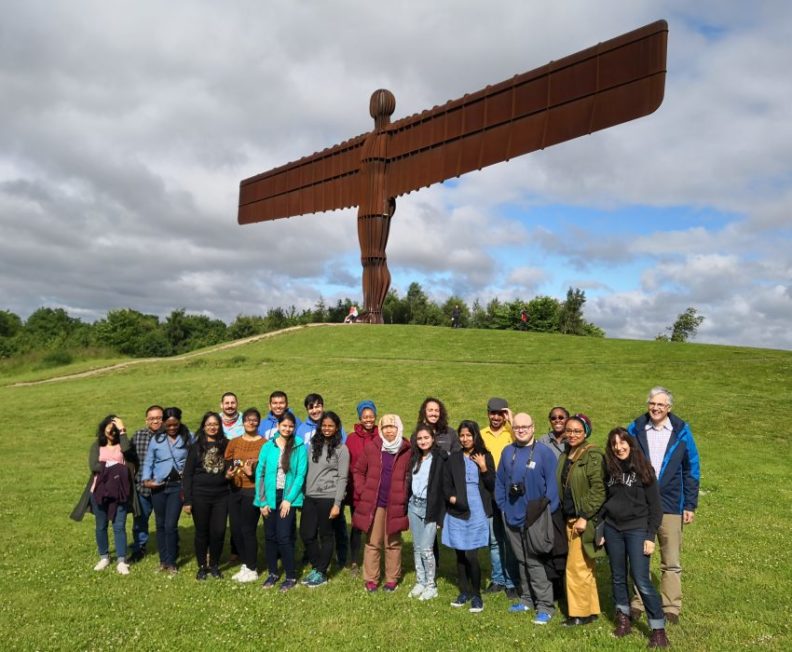Major Rubaramira Ruranga opens Research Dissemination Exhibition
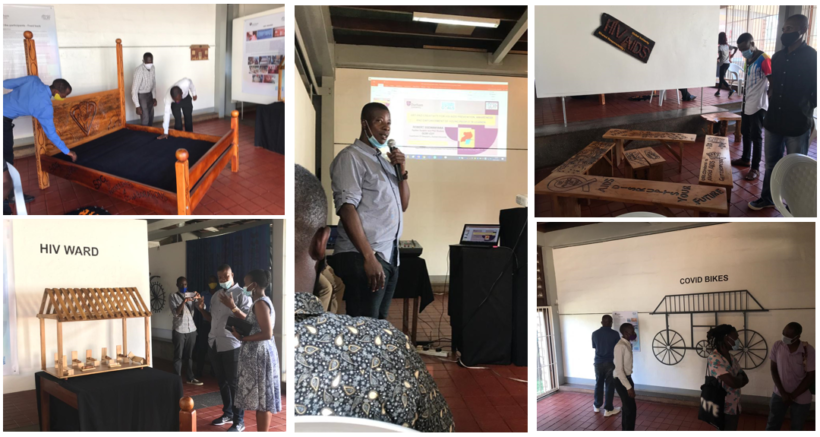
On the 4th January 2021 an event dubbed as a “Research Dissemination Exhibition”, was launched at the Makerere University Art gallery. The Makerere Institute of heritage, conservation and restoration (MIHCR) organised the exhibition on my behalf and sponsored by GCRF-CDT- Durham University. It was officially opened by Retired Major Rubaramira Ruranga, CEO of the National Guidance Network of People Living with HIV/AIDS (NGEN+), a local NGO which partnered with Durham University to oversee my research in Uganda. It was put up to provide an interactive platform for engaging, sharing and disseminating research findings with local communities, research participants, HIV advocates, activists, academicians, Ministries and other stakeholders in the fight against HIV/AIDS in Uganda. I am happy to report that over 30 attendees were present at the launch as several notable personalities and organisations were represented. They included the following among others;
The Deputy Vice Chancellor (DVC), Makerere University (Prof. Josephine Nabukenya)
The Dean, School of Fine Art, CEDAT, MUK (Assoc Prof. Kizito Maria Kasule)
College Public relations officer, CEDAT (Mrs Betty Kyakuwa)
The Head, Makerere Institute of Heritage, Conservation and Restoration (Prof. George Kyeyune)
- Faculty Colleagues, School of Fine Art, CEDAT, Makerere University
- CEO NGEN+ (Retired Major Rubaramira Ruranga) – Guest of Honour
- Centre Manager, The AIDS Support Organisation (TASO), Mulago, Kampala (Mr Robert Nkabala)
- Research Administrator, BAYLOR School of Medicine, Mulago (Mr Henry Balwa)
- 10 Research participants from Bwaise, Ndeeba and Katwe (Selected sites where the research was conducted)
- 3 Village Health Team (VHT) members of Lungujja Community health care Organisation (LUCOHECO)
- Media Houses (Life TV, New vision, Red Pepper newspapers, etc.)
- Infectious Disease Institute – IDI Academy, Makerere University (Ms Ruth Nalunga and Anna Kucma)
- Students from Makerere University and other higher institutions of teaching and learning
- Ms Ntege Angella, rights activist and adolescent reproductive health Advocate, International community for women Living with HIV/AIDS East Africa (ICWEA), to mention but a few.
Below are brief notes and images about some of the artworks co-produced by young people (Covid bikes, the HIV ward, the HIV benches and the bed headboard)
Artwork 1: HIV Benches
Medium: wood
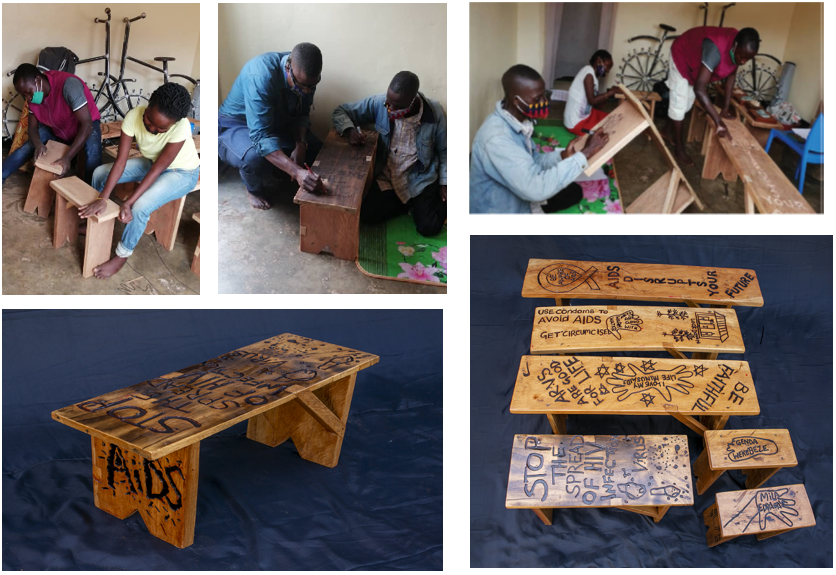
Wooden benches are common objects in every open space in Uganda. In urban centres were the youth largely inhabit, the benches are frequently used as seats in markets, food kiosks, bars and gaming spaces were popular games like ludo and sporting betting are played. The bench is an affordable seating tool and therefore is used by large groups of people in the community. With the technique of inscribing them with activism statements like “Stop The Spread of HIV/AIDS” or “Genda Wekebeze” (go and test) and familiar drawings connoting the spread and fight of the disease, this immediately will spark conversation on the virus. It is important to inspire conversations on the disease in social spaces because particular individuals often grapple with the challenge of stigma leading to discrimination and eventually depression. Through opening up, such barriers are shuttered and deaths gradually reduced.
Additionally, it is important to consider the process of sculpting these benches as another avenue to open up conversation on the pandemic. Naturally, these utilitarian objects were collectively made in a group with each artisan required to perform a specific task like cutting the timber, measuring the length and sanding the wood surfaces. Such collaborative schemes was evident in the production of these benches. Through co-production, personal experiences of HIV/AIDS were revealed by the participants. The benefits of such collaborative approach was to produce an authentic and relevant visual expressions that relate to the local community.
Artwork 2: Covid Bikes
Medium: Wrought Iron
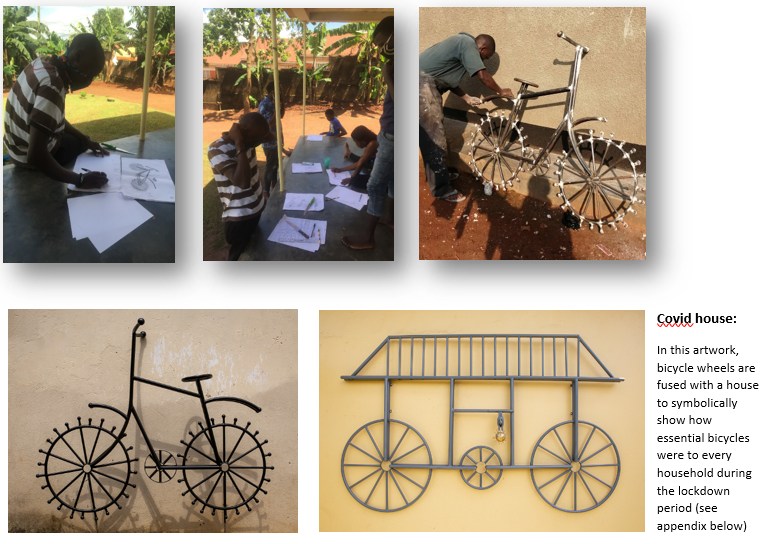
A bicycle is a common means of transport both in urban and rural settings across Uganda. Bicycles are relied on as a cheap form of transport to markets, hospitals and other respective work places. During the total lockdown imposed by government to curtail the spread of Covid-19, the bicycle became the most effective means of transport because it is cheap to maintain and easily accessible. The notion of produce bicycles for the research exercise on HIV/AIDS among the youth in informal spaces, was largely influenced by the series of conversations the participants had on how the local people had to deal with disease during the nation wide total lockdown. It therefore, emerged that HIV/AIDS patients had to rely on the bicycle to transport them to distant health facilities to acquire their routine medication (Louise, 2020). However, the use of bicycles (Shaughnessy, n.d.) didn’t only facilitate the saving of lives, but inspired a more critical aspect in the fight against the disease by breaking down social stigma and discrimination. Probably, for the first time during my research, HIV positive participants freely talked about their personal experiences with the diseases with each other and those in immediate surroundings as the sought to get help to reach the hospitals. The technique of adding Covid spikes on the wheels, is intended to give the artwork the context within which it was created for.
Artwork 3: HIV Ward
Medium: Wood

In this body of work, I collaborated with a group of young artisans in Ndeeba, Kampala to produce a series that interrogate the subject of death by Aids patients. This artworks further expose the structural inadequacies like unprofessional conduct by health workers, lack of medicine and poor sanitation in many health facilities across the country that lead to many deaths. This has always been the case in most government hospitals in Uganda as the health ministry grapples with the ever surging numbers of adolescent HIV/AIDS patients with huge funding gaps as is the case in South Africa (Subedar et al., 2018). The concept was conceived out of a personal experience by one of the participants in the workshops who had a sick relative admitted in hospital. The traumatizing experience encountered by Franklin- witnessing several people die every hour of the day- exposes the dire condition of hospitals and the unprofessional behaviour of the medical personnel while dealing with the critically ill.
Beyond its ability to expose the inadequacies in our health system within the context of AIDS treatment, the artwork implores our collective responsibility to deal with the stigma attached to the treatment of the disease. The effort undertaken by Franklin to disclose such inhumane treatment, can lead to the community to hold accountable the health workers to act more responsibly while treating patients, hence saving more lives.
Artwork 4: ‘Omutima gw’omulenzi gubeera eno eneeri’
(Translates: Young men’s hearts are like blue-tooth)
Medium: Wood

Young people often find a challenge of controlling their sexual behaviour because of peer pressure from friends and society’s dictates influenced by cultural beliefs. As a result of such influence many young men find it necessary to explore and exercise their masculinity by having several sex partners. The installation in form of a bed examines the trend of having multiple sex partners and yet one is in a steady relationship. One of the participants, Chan Izeyo 24, chose to use familiar symbols like the shape of the heart to allude to love and commitment. Inside the heart, is a pigeon bird representing the act of sharing between the couple. Ironically, inside the pigeon is a silver fish (Mukene) a local symbol used to refer to multiple sex partners. The multi- faceted motif rests on the face of the bed alongside other bold inscriptions that convey the message of Aids prevention and awareness.
This captivating installation is a classic tool to create awareness on the disease. As one of the guests at the opening of the exhibition pointed out, “this installation can suffice during Valentine’s Day celebrations where many youth use the day to indulge their sexual appetite with multiple partners in lodges”. Research has indicated that on Valentine’s Day, there’re high levels of sex activities among young people as an excuse of testing their love for each other. The installation therefore become a tool to fight the spread of the disease.
In conclusion, the artworks above (applied objects) re- echo the need to engage the local communities in the fight against the disease. Furthermore these applied art forms, explore a critical aspect in the fight against the disease using a collaborative approach. These co-produced objects were meant to break down the social stereotypes, discrimination and stigma to HIV/AIDS whilst empowering marginalized young artisans economically. This reminisces the works and social of engagements of Kate wells with the HIV positive craftswomen from Kwazulu Natal, one of the epicentre of HIV/AIDS in South Africa (Wells, 2012). Additionally, it is equally important to note that applied sculpture was able to facilitate and stimulate conversation and dialogue about key social issues affecting the young artisans in the context of the two colliding pandemics;-HIV/AIDS and COVID-19: inevitably reflecting on everyday experiences of the participants and their immediate surroundings. I arguably, contend that it facilitated an authentic and relevant visual expression and narrative. As such, the role played by art (applied sculpture) in finding solutions to social problems cannot be under scored. Thus, it remains to be seen, if the dissemination of these research findings could potentially inform and advance new pathways for improved policy decisions and advocacy among providers of healthcare services, stakeholders in the fight against HIV/AIDS and relevant ministries in Uganda (Integrating art as a vehicle in the fight against the now surging number of HIV infections among youth in informal spaces).
Appendix
The Covid House: This artwork presents a two-in one concept where a house with a covid padlock symbolises people being ‘locked up’ with abusers during the lockdown period in March to June 2020 when the spread of the corona virus was at its peak. Reports from local authorities and police showed that this led to a sharp increase in cases of domestic violence and sexual abuses against women and young girls which conquently fueled the spread of HIV and unwanted pregnancies in many communities (Amanda Taub, 2020; Kirunda, 2020). The house is then cojoined to a set of wheels to represent the essence of having a bicycle particularly for people living with HIV to collect ARVs from hospitals. According to the participants, having a bicycle in a home was a great relief to them because many could not afford to go to LCs for permission to use vehicles, as required by government, since they never wanted to disclose their status to local officials. Government had since banned all forms of public transport when it announced a nationwide lockdown due to covid-19.

Abuser within: This artwork was concieved by participants during the lockdown art and creativity workshop in Lungujja, Kampala. It was conceptualized from the experiences young people were going through especially when confinement in homes subjected them to domestic violence and sexual abuse on the part of vulnerable young women and girls. The nationwide lockdown and the the stringent state-led restrictions to curb the spread of corona virus forced people to stay and work from homes.
The artwork is a depiction of a wooden house with a closed door and a covid padlock used to symbolise the negative consequences of the pandemic to households in communities. The numerous nails covering the side of the house represent the agony and pain of confinement in one space- sexual assault/abuse, physical abuse by men, Famine and so on. This conquently fuelled the spread of HIV and unwanted pregnancies in many communities.
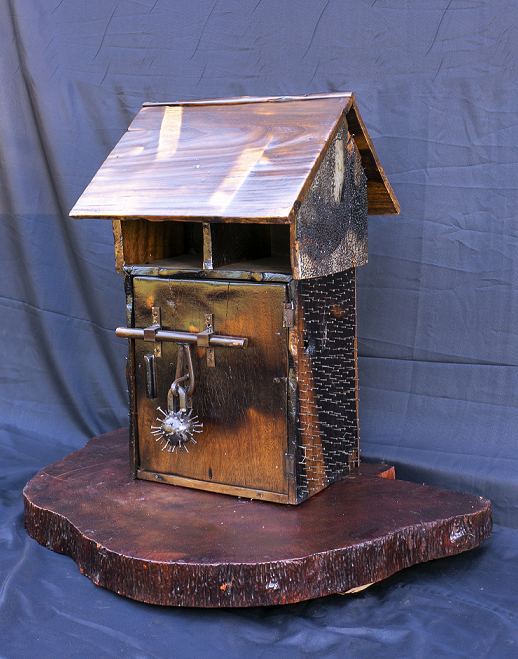
Bibliography
Amanda Taub. (2020). How Domestic Abuse Has Risen Worldwide Since Coronavirus – The New York Times. THE NEWYORK TIMES. Retrieved from https://www.nytimes.com/2020/04/06/world/coronavirus-domestic-violence.html
Berman, K. S. (2017). Finding Voice: A Visual Arts Approach to Engaging Social Change. Retrieved from https://books.google.co.uk/books?hl=en&lr=&id=3pdFDwAAQBAJ&oi=fnd&pg=PR9&dq=finding+a+voice+by+kim+berman&ots=MlPYrwzg3I&sig=L2PfIP9sKk79ifkqSe7e7T0zVSU#v=onepage&q=finding a voice by kim berman&f=false
Boneh, G., & Jaganath, D. (2011). Performance as a component of HIV/AIDS education: Process and Collaboration for Empowerment and Discussion. American Journal of Public Health, 101(3), 455–464. https://doi.org/10.2105/AJPH.2009.171991
Kirunda, A. (2020). Man stabbed to death in domestic fight – 93.3 KFM. Retrieved from https://www.kfm.co.ug/news/man-stabbed-to-death-in-domestic-fight.html
Louise, D. (2020). A transport ban in Uganda means women are trapped at home with their abusers – CNN. Retrieved May 15, 2020, from CNN website: https://edition.cnn.com/2020/05/15/africa/uganda-domestic-violence-as-equals-intl/index.html
Nabulime, L. M. (2007). The role of sculptural forms as a communication tool in lives and experiences of women with HIV/AIDS in Uganda. Retrieved from http://dspace.mak.ac.ug/handle/10570/4718
Prentki, T., & Preston, S. (2013). The Applied Theatre Reader. Retrieved from https://books.google.co.uk/books?hl=en&lr=&id=WinhAQAAQBAJ&oi=fnd&pg=PP1&dq=Community+based+theatre&ots=0GwvAfZJ3p&sig=CpZ5w5Vjt6tmYyk7LrtwBE-nTTo#v=onepage&q=Community based theatre&f=false
Shaughnessy, N. (n.d.). Applying performance : live art, socially engaged theatre and affective practice. Retrieved from https://books.google.co.uk/books?hl=en&lr=&id=5s7fExfj6oIC&oi=fnd&pg=PP2&dq=living+as+form%3B+socially+engaged+art&ots=zaNPZWTUi9&sig=K9G2p6PD-tNyUCFxO84DvagNv_c#v=onepage&q=living as form%3B socially engaged art&f=false
Subedar, H., Barnett, S., Chaka, T., Dladla, S., Hagerman, E., Jenkins, S., … Pillay, Y. (2018). Tackling HIV by empowering adolescent girls and young women: a multisectoral, government led campaign in South Africa. BMJ (Clinical Research Ed.), 363, k4585. https://doi.org/10.1136/bmj.k4585
Wells, K. (2012). Siyazama : art, AIDS, and education in South Africa. Retrieved from http://nrl.northumbria.ac.uk/9448/

